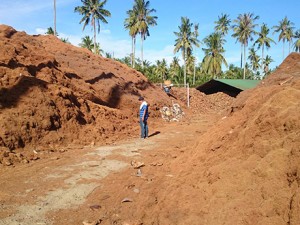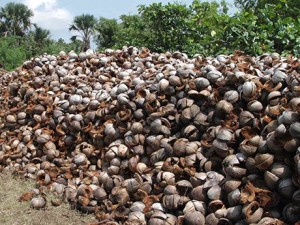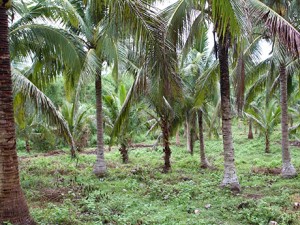Coconut shell materials



Product characteristics
- use
- Horticultural materials; stuffing fiber for pillows, stuffed toys, and cushions; oil absorption materials; new blended clothes
- area
- Southeast Asia, tropical America, tropical Africa
- overview
-
Coir is a hard, strong and elastic fiber, red-brown in color, that is extracted from the mesocarp of coconuts. It consists of coco fiber and non-fiber residues (cocopeat and coco pith). Coco fiber is used for products such as brushes, mats, ropes, and coarse furniture mattresses. Cocopeat (residue left after fiber is extracted from coir fiber) consists of residual fiber and lignin pith. Cocopeat is used as a horticultural material. Compared to peat moss, it has superior properties: smaller burden on the natural environment as it is more recyclable; high water-holding capacity and superior ability to drain excessive water; and high durability and fertilizer retention ability. However, cocopeat is underutilized, except in a few countries such as India and Sri Lanka, and is commonly disposed of as a waste.
In recent years, there is a concern that cocopeat resources in Sri Lanka are depleting. Traditionally in Sri Lanka, coconut waste left in the open air for a long period of time (for several decades) ages by losing its salt and tannin contents and, if considered suitable, is used as horticultural material. The waste turns its color from brown to black during many years of aging and is thus called black peat. However, the amount of Sri Lankan black peat is said to be decreasing and currently, un-aged coconut waste is therefore collected and washed (among other processing) to accelerate aging (i.e., red peat). The quality of red peat is influenced greatly by the extent of processing and is not necessarily superior to the aforementioned peat moss; in some extreme cases, red peat causes growth problems to crops. In response, some exporters have independently established quality standards with which they grade peat products: the Philippines has established national standards and New Zealand now has quality standards for importing peats.
Abandoned biomass
The raw material of coir is the mesocarp of coconuts. A coconut consists of green epicarp (the outside surface of the nut), mesocarp (the flesh, composed of strong fiber), endocarp (the woody hard seed coat), copra (white and solid endosperm attached to the entire inner surface of the endocarp), and liquid endosperm (coconut water) that fills the seed. The mesocarp biomass, the raw material of the coconut shell fiber, accounts for 33% of the weight of the fruit. Only 10% (of the total nut weight) can be used as fiber and the waste, left after fiber extraction, is used as cocopeat.
Coir production potential varies by country: 1.75 million t for Indonesia, 1.52 million t for the Philippines, 1.02 million t for India, and 200,000 t for Sri Lanka. However, the actual exports are far below their potentials: 46,000 t for Indonesia, 11,000 t for the Philippines, 360,000 t for India, and 110,000 t for Sri Lanka. It is suggested that one reason for this gap is the production of coconut milk. Because unripe fruits are used to collect coconut milk, the fiber left after extraction is not mature, making it unusable in products. For India and Sri Lanka, considering the amount of coconuts used to produce coconut milk in these countries, it can be said that available coconut biomass is satisfactorily being used there. However, in Indonesia and the Philippines, the first and second largest producers of coconuts in the world, it is believed that coir has been disposed of as abandoned biomass. It is expected that, with effective measures for promoting coir use, these countries can become important coir suppliers in the future.
Export and import trends, demands in Japan
Japan’s import of coir products significantly increased in the 1990s and 2000s, and since 2010, it has gradually increased or flattened out. Imports from the Philippines increased in the 1990s and 2000s, but have since taken a downward turn, accounting for only 0.56% of the total import from Asia in 2014. Imports from Sri Lanka have dramatically increased, doubling from 2000 to 2014, and have accounted for 80–90% of the country’s total coir import since 2000. Imports from India have not increased; it was 433 t in 2014 (0.64% of the total import from Asia). It is suggested that low imports from the Philippines and India are due to price competition: relatively higher prices of the coir from the Philippines and India, compared with the price of Sri Lankan coir. Lower prices of Sri Lankan coir products are believed to be due to the country’s intensive coir production system, developed through its long production history of the products and cheap transport costs realized by large transaction volumes. As of 2016, export of coir products to Japan is not producing profit due to a strong yen; further cost reduction is required to increase transactions.
Japan used to import coco fiber from Sri Lanka as a raw material for scrubbing brushes. As for cocopeat, in addition to it being used as a substitute for peat moss, coco disks (dry growing media used by saturating it with water) and Jiffypots (planting pots that break down naturally over time, allowing plants to be planted with these pots, thereby avoiding damage to the plants and increasing their chance of survival) have been developed. These products are usually sold at in stores specializing in gardening and home improvement.
Also, in recent years, the container cultivation of seedlings for forestry use has been investigated and, as part of it, a growth test has been carried out using cocopeat as a growing medium. Furthermore, the potential of cocopeat as a slope erosion barrier and a growing medium for slope-growing plants is being investigated, and its future use is expected. In addition, product development is ongoing in regard to the use of cocopeat as a bedding material in livestock barns (as a deodorant material) and as a mushroom growing medium.
Market prospects
In response to the reduction of peat moss resources and the environmental impact of its use, Canada and the U.S., peat moss producers, and the Netherlands, a consumer of horticultural materials, are shifting from peat moss to cocopeat. According to statistics on India’s export of cocopeat (the number of shipments between January 2014 and January 2016), the Netherlands is the largest destination at 3,253 shipments, followed by the U.S. at 2,678 shipments; these two countries account for 40% of the total shipments.
In the past, coir was traded within the frame of Sri Lanka as a producer and Europe as a consumer. However, in recent years, demands in the U.S. and China have increased, respectively accounting for 9.3% and 68.7% of the world’s total import (Europe at 16.8%). Between 2007 and 2012, the imports by these countries increased dramatically: three-fold increase for the U.S. and two-fold increase for China. China, which imports over half of the world’s total coir import, has a key for future commercial transactions (both in quantity and value).
- references
-
- FAO Statistical Bulletins -Statistic November 2012


